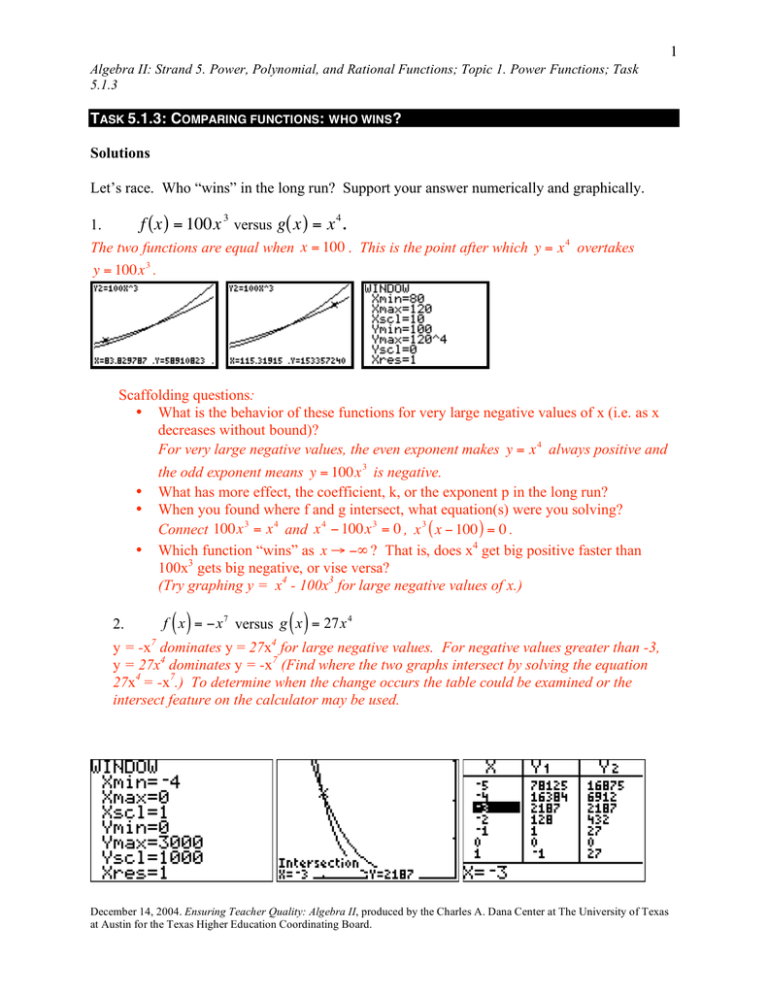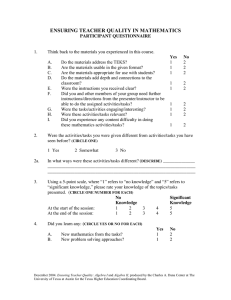( ) f x g x x
advertisement

1 Algebra II: Strand 5. Power, Polynomial, and Rational Functions; Topic 1. Power Functions; Task 5.1.3 TASK 5.1.3: COMPARING FUNCTIONS: WHO WINS? Solutions Let’s race. Who “wins” in the long run? Support your answer numerically and graphically. 3 4 1. f (x ) = 100x versus g( x ) = x . The two functions are equal when x = 100 . This is the point after which y = x 4 overtakes y = 100x 3 . Scaffolding questions: • What is the behavior of these functions for very large negative values of x (i.e. as x decreases without bound)? For very large negative values, the even exponent makes y = x 4 always positive and the odd exponent means y = 100x 3 is negative. • What has more effect, the coefficient, k, or the exponent p in the long run? • When you found where f and g intersect, what equation(s) were you solving? Connect 100x 3 = x 4 and x 4 ! 100x 3 = 0 , x 3 ( x ! 100 ) = 0 . • Which function “wins” as x ! "# ? That is, does x4 get big positive faster than 100x3 gets big negative, or vise versa? (Try graphing y = x4 - 100x3 for large negative values of x.) () () f x = !x 7 versus g x = 27x 4 2. 7 4 y = -x dominates y = 27x for large negative values. For negative values greater than -3, y = 27x4 dominates y = -x7 (Find where the two graphs intersect by solving the equation 27x4 = -x7.) To determine when the change occurs the table could be examined or the intersect feature on the calculator may be used. December 14, 2004. Ensuring Teacher Quality: Algebra II, produced by the Charles A. Dana Center at The University of Texas at Austin for the Texas Higher Education Coordinating Board. 2 Algebra II: Strand 5. Power, Polynomial, and Rational Functions; Topic 1. Power Functions; Task 5.1.3 Scaffolding questions: • How did you decide what graphing window to use? • As x ! +" , which function is changing fastest: f as it decreases or g as it increases? To answer this question, examine the difference (f – g) of the two functions. The gap between the functions gets bigger and bigger negative as x increases, so f “wins”. 1 f x = x 5 versus g x = 5x 3 . 5 1 In the long run, f x = x 5 dominates g(x) = 5x3. The two functions are equal at x = -5 and 5 at x = 5. To see this, solve the equation f(x) = g(x). Use two different windows to show the relative behavior of the functions. 3. () () () Teaching notes This task will build the ideas to be used in the leading term test for determining the long run behavior of a polynomial. Take a moment to discuss what it means for one function to “win” when compared to another. Assign each group one of the three exercises. Ask them to justify their reasoning using large grid paper and to present their findings to the group. December 14, 2004. Ensuring Teacher Quality: Algebra II, produced by the Charles A. Dana Center at The University of Texas at Austin for the Texas Higher Education Coordinating Board. 3 Algebra II: Strand 5. Power, Polynomial, and Rational Functions; Topic 1. Power Functions; Task 5.1.3 TASK 5.1.3: COMPARING FUNCTIONS: WHO WINS? Let’s race. Who “wins” in the long run? Support your answer numerically and graphically. 1. f (x ) = 100x 3 versus g( x ) = x 4 . 2. f x = !x 7 versus g x = 27x 4 . 3. 1 f x = x 5 versus g x = 5x 3 . 5 () () () () December 14, 2004. Ensuring Teacher Quality: Algebra II, produced by the Charles A. Dana Center at The University of Texas at Austin for the Texas Higher Education Coordinating Board.

